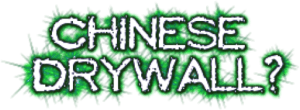Corrosive Drywall

 The home resale market in Florida is booming today.
The home resale market in Florida is booming today.
That’s the good news!
Many of the homes being sold are either foreclosed or short-sales. According to ‘Florida Realtor®’ over 227K single family homes were sold in 2013. Of those 227K, 72K homes were foreclosures or short-sales – 32% of the total.
In most cases, the buyer is getting a good deal. Since many of these distressed home sales have been unoccupied for a period of time, the buyer must seek inspections to assure the home is not a “pig in the poke.” Obviously, a general home inspection is very important. Licensed home inspectors can identify problems with structural, plumbing and electrical systems. Mold inspections are critical in foreclosed properties because many have been without power and air conditioning for long periods of time. Moisture tends to accumulate to dangerous levels in unoccupied homes.
Corrosive drywall (CDW) – more commonly called Chinese drywall – is just one more problem facing Florida home-purchasers.
Corrosive (Chinese) drywall problems started in 2004 when the North American sources of gypsum wall board (drywall) were challenged by the high demand from the construction boom. Unfortunately the boom in the U.S. market opened the door for imports from China. Drywall from China was imported primarily from 2004 to 2007 and used in homes in primarily in the Southeast, i.e. Florida, Louisiana, Alabama and Virginia.
Problems caused by these defective products did not become obvious until long after they were incorporated into many homes built or remodeled during that time. The Consumer Product Safety Commission (CPSC) started receiving consumer complaints about drywall in 2008. The first indications of problems were noticed when noxious sulfur odors rendered the home difficult to occupy. Many of the homes built during the era of corrosive drywall (CDW) are now the foreclosed homes on the market today and may not be as obvious as people may think. Not all CDW homes have that noticeable noxious sulfur odor at all times.
Understanding the issue of Corrosive Drywall (CDW) almost requires a degree in chemistry. The ingredients blended into CDW vary from batch to batch. The one common element observed to date is that sulfur gasses are the source of the odors. The sulfur gasses cause copper parts to discolor and eventually fail. The problems with the CDW were not discovered until air conditioning and plumbing failed.
Some health issues have been identified with CDW exposure, the most commonly reported symptoms include irritated and itchy eyes and skin, upper respiratory and breathing difficulties, persistent cough, bloody noses, runny noses, recurring headaches, sinus infection, and asthma attacks.
At this time, many people feel that by now all CDW homes have been discovered or are very obvious. That is a false assumption. The basic problem is that very rarely is the drywall used in one home 100% corrosive or non-corrosive. From our independent findings, as much as 95% of the home may have been built with corrosive drywall with the balance being non-corrosive. Conversely, only 5% of the drywall may have been corrosive. The point is that if the home you are looking to purchase is made with a smaller percentage of corrosive drywall, the obvious signs of sulfur odors may not be evident. For that reason, a Corrosive Drywall (CDW) Syndrome inspection is crucial in homes built or remolded in that era.
Ten years ago no one had ever heard of Corrosive Drywall – commonly called Chinese Drywall. Today it is a well-known problem and should not be overlooked when purchasing a home built or renovated between 2005 and 2009. Alpha Environmental offers inspection for Corrosive Drywall Syndrome which can lead to testing of the actual suspect drywall, as needed.
Not sure if you need a CDW inspection when purchasing a home? Call Alpha Environmental to speak to a trained and Board-Certified professional who can give you the information you need to make a decision.
